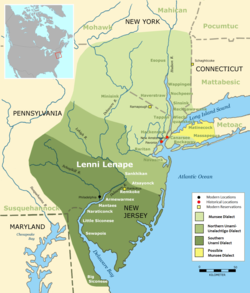
Back Lenni-Lenape Afrikaans Delavarlar Azerbaijani Ленапэ Byelorussian Делавари Bulgarian Lenapes Catalan Lenapové Czech Lenape Danish Lenni Lenape German Lenapoj Esperanto Lenape Spanish
Delaware: Lënapeyok | |
|---|---|
 The Lenape territory, known as Lenapehoking, as of the 16th and 17th centuries, with speakers of Munsee (north), Unalachtigo (center), and Unami (south). Inset: The location of the region in the present-day United States.[1][2][3] | |
| Total population | |
| c. 16,000[4] | |
| Regions with significant populations | |
| Oklahoma, U.S. | 11,195 (2010)[5] |
| Wisconsin, U.S. | 1,565 |
| Ontario, Canada | 2,300 |
| Languages | |
| English, Munsee, and Unami[4] as a second language | |
| Religion | |
| Christianity, Native American Church, traditional tribal religion | |
| Related ethnic groups | |
| Other Algonquian peoples | |
| Person | Lënape (Monsi / Wënami) |
|---|---|
| People | Lënapeyok (Monsiyok / Wënamiyok) |
| Language | Lënapei èlixsuwakàn (Monsii èlixsuwakàn / Wënami èlixsuwakàn) |
| Country | Lënapehòkink (Monsihòkink / Wënamihòkink) |

The Lenape (English: /ləˈnɑːpi/, /-peɪ/, /ˈlɛnəpi/;[7][8] Lenape languages: [lənaːpe][9]), also called the Lenni Lenape[10] and Delaware people,[11] are an Indigenous people of the Northeastern Woodlands, who live in the United States and Canada.[4]
The Lenape's historical territory includes present-day northeastern Delaware, all of New Jersey, the eastern Pennsylvania regions of the Lehigh Valley and Northeastern Pennsylvania, and New York Bay, western Long Island, and the lower Hudson Valley in New York state.[notes 1] Today they are based in Oklahoma, Wisconsin, and Ontario.
During the last decades of the 18th century, European settlers and the effects of the American Revolutionary War displaced most Lenape from their homelands[12] and pushed them north and west. In the 1860s, under the Indian removal policy, the U.S. federal government relocated most Lenape remaining in the Eastern United States to the Indian Territory and surrounding regions. Lenape people currently belong to the Delaware Nation and Delaware Tribe of Indians in Oklahoma, the Stockbridge–Munsee Community in Wisconsin, and the Munsee-Delaware Nation, Moravian of the Thames First Nation, and Delaware of Six Nations in Ontario.
- ^ Cite error: The named reference
n10was invoked but never defined (see the help page). - ^ Fariello, Leonardo A. "A Place Called Whippany" Archived July 27, 2013, at the Wayback Machine, Whippanong Library, 2000 (retrieved July 19, 2011)
- ^ Kraft, The Lenape-Delaware Indian Heritage,[page needed]
- ^ a b c Pritzker 422
- ^ "Pocket Pictorial." Archived 2010-04-06 at the Wayback Machine Oklahoma Indian Affairs Commission. 2010: 13. Retrieved 10 June 2010.
- ^ "Art on the Prairies: Delaware", All About the Shoes. Retrieved 19 July 2011.
- ^ "Definition of Lenape". Merriam Webster. Archived from the original on August 13, 2019. Retrieved July 6, 2017.
- ^ "Lenape". Dictionary.com. 2023.
- ^ "Delaware Indians". Lenape Talking Dictionary. Delaware Tribe of Indians. Retrieved February 24, 2023.
- ^ Zeisberger, David (1827). Grammar of the language of the Lenni Lenape or Delaware Indians. Philadelphia: James Kay. ISBN 978-0-404-15803-3.
- ^ William, Brandon (1961). Alvin M., Josephy Jr. (ed.). The American Heritage Book of Indians. American Heritage Publishing Co., Inc. pp. 180–211. LCCN 61-14871.
- ^ Cite error: The named reference
josephywas invoked but never defined (see the help page).
Cite error: There are <ref group=notes> tags on this page, but the references will not show without a {{reflist|group=notes}} template (see the help page).